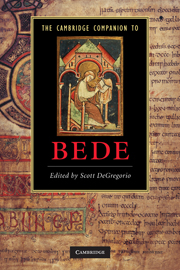Book contents
13 - The cult of Bede
from Part III - Reception and Influence
Published online by Cambridge University Press: 28 January 2011
Summary
The aim of this chapter is to explore when, where and to what extent Bede was treated as a saint in the medieval period. In the early Middle Ages, there existed no generally agreed process for recognizing saints. Not until the twelfth century did the popes take control of the process of canonization, based on evidence of the saint's posthumous miracles and, in the case of a martyr, manner of death, or, in the case of a confessor, outstandingly virtuous life. This process, however, did not apply to those who were already being treated as saints. Bede was certainly never canonized in the formal sense. In 836, the Council of Aachen called him 'venerable', but not so much as a title as in the context of a description of him as 'the priest Bede, in these modern times a venerable and admirable teacher'. Only in 1899 did the pope give him the title of Doctor of the Church, with his feast being formally adopted into the Roman Catholic Church but placed since 1969 on 25 May, rather than 26 or 27 May, on which it was generally celebrated in the Middle Ages. If Bede was treated as a saint in earlier periods, it must have been in the vaguer, more local, more informal way by which saints were recognized before the advent of papal canonization. There seem to have been several parts to this process. Firstly, someone had to compose texts that described the saint's life, death and miracles, working from a variety of sources, including oral tradition, possibly with a strong local flavour (that is, such a tradition would be strongest in areas invested in Bede's reputation).
- Type
- Chapter
- Information
- The Cambridge Companion to Bede , pp. 193 - 200Publisher: Cambridge University PressPrint publication year: 2010
- 3
- Cited by



